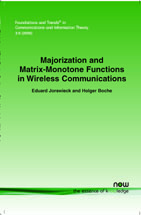Majorization and Matrix-Monotone Functions in Wireless Communications
By Eduard Jorswieck, Royal Institute of Technology, Department of Electrical Engineering, Signal Processing, Sweden, eduard.jorswieck@ee.kth.se | Holger Boche, Technical University of Berlin, Department of Electrical Engineering, Heinrich-Hertz Chair for Mobile Communications, Germany and Fraunhofer German-Sino Lab for Mobile Communications MCI, Germany and Fraunhofer Institute for Telecommunications, Heinrich-Hertz-Institut, Germany, holger.boche@hhi.fhg.de
Abstract
This short tutorial presents two mathematical techniques namely Majorization Theory and Matrix-Monotone Functions, reviews their basic definitions and describes their concepts clearly with many illustrative examples. In addition to this tutorial, new results are presented with respect to Schur-convex functions and regarding the properties of matrix-monotone functions.
The techniques are applied to solve communication and information theoretic problems in wireless communications. The impact of spatial correlation in multiple antenna systems is characterized for many important performance measures, e.g., average mutual information, outage probability, error performance, minimum $\farc{E_{b}}{N_{0}}$ and wideband slope, zero-outage capacity, and capacity region. The impact of user distribution in cellular systems is characterized for different scenarios including perfectly informed transmitters and receivers, regarding, e.g., the average sum rate, the outage sum rate, maximum throughput. Finally, a unified framework for the performance analysis of multiple antenna systems is developed based on matrix-monotone functions. The optimization of transmit strategies for multiple antennas is carried out by optimization of matrix-monotone functions. The results within this framework resemble and complement the various results on optimal transmit strategies in single-user and multiple-user multiple-antenna systems.
Majorization and Matrix Monotone Functions in Wireless Communications
Majorization Theory and Matrix-Monotone Functions in Wireless Communications reviews the basic definitions of Majorization Theory and Matrix-Monotone Functions, describing their concepts clearly with many illustrative examples. In addition to this tutorial, new results are presented with respect to Schur-convex functions and regarding the properties of matrix-monotone functions. The approach taken by the authors provides a valuable overview of the basic techniques for readers who are new to the subject. They then proceed to show in separate chapters the cutting edge applications of the two basic theories in wireless communications.
Majorization Theory and Matrix-Monotone Functions in Wireless Communications is an invaluable resource for students, researchers and practitioners involved in the state-of-the-art design of wireless communication systems.
